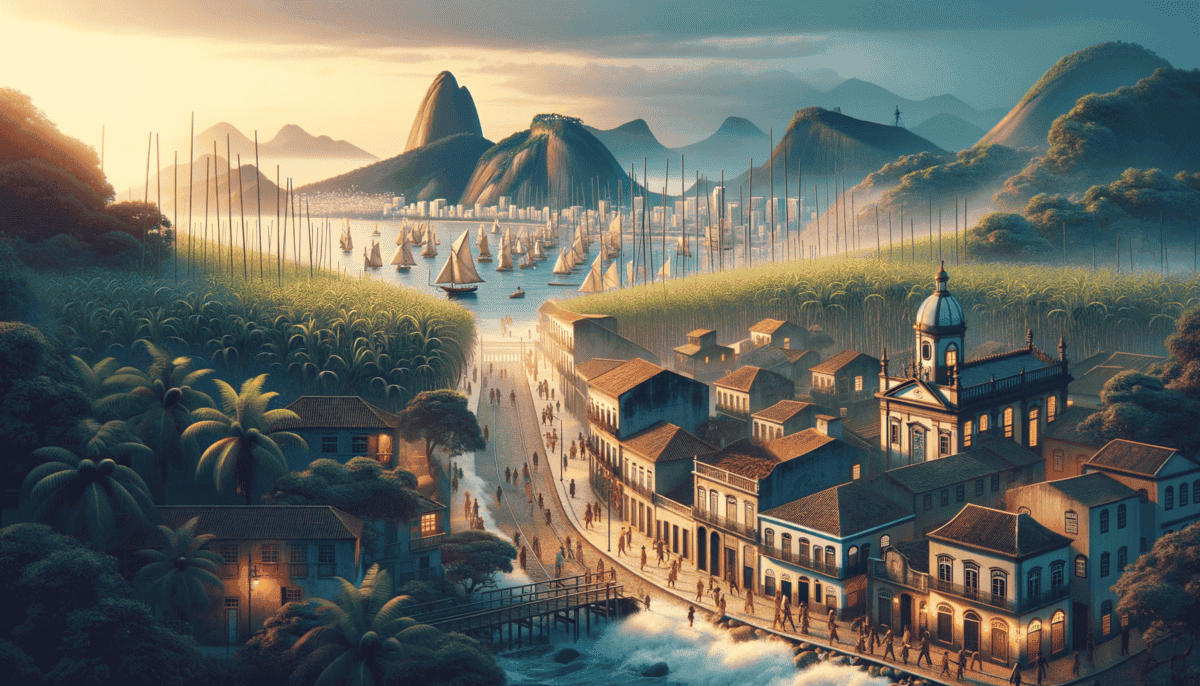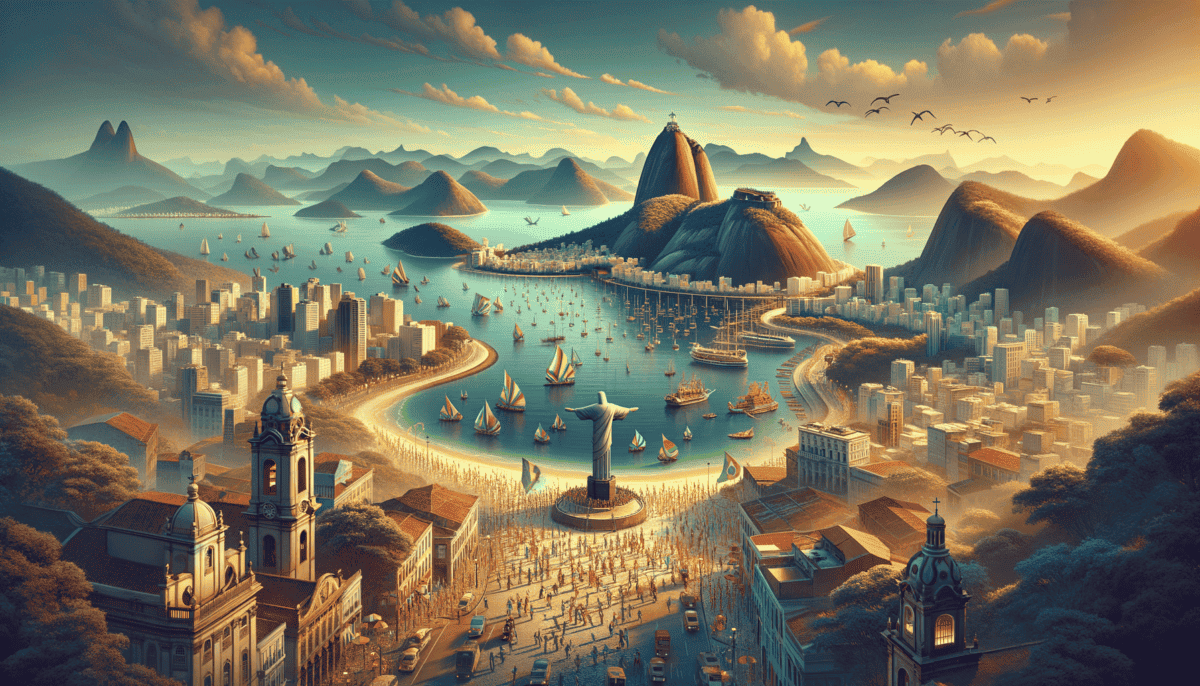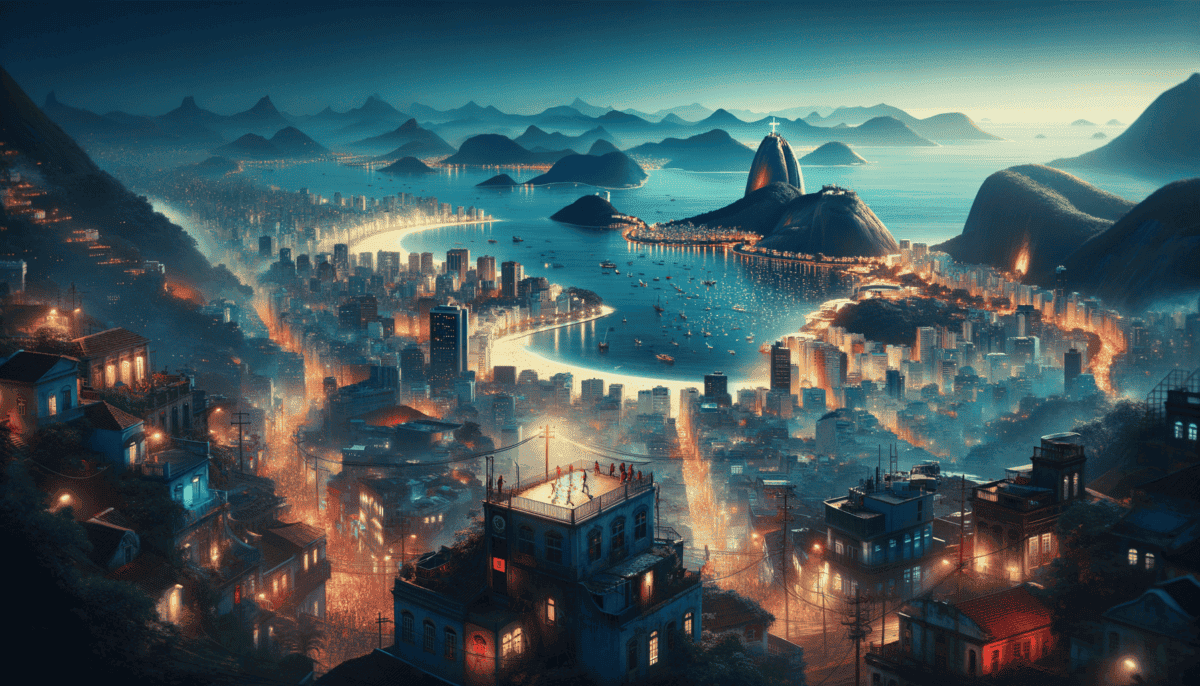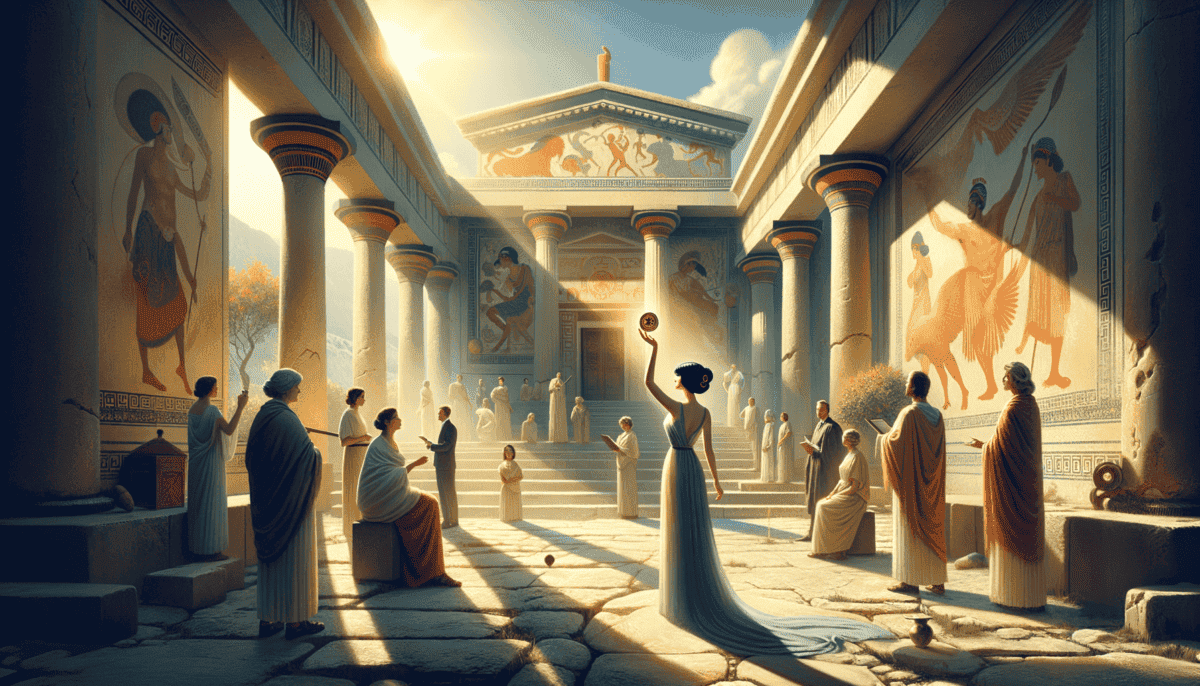Discovery of Paradise
The sun sparkled over the beautiful blue waters of Guanabara Bay. It was January 1502, and Portuguese ships sailed into one of the most stunning places they had ever seen.
"Look at those mountains!" called out Captain Gaspar de Lemos. "They look like giants watching over the bay!" ️
The sailors gazed in wonder at the steep green hills rising from the water. Birds with colorful feathers flew overhead. The air was warm and sweet with tropical flowers.
Meeting New Friends
On the shore, the Tamoio people watched the strange ships arrive. They had lived in this paradise for thousands of years. The Tamoio were clever and brave. They knew how to farm the land and fish in the rich waters.
"Who are these pale-skinned visitors?" the Tamoio children asked their parents.
The Portuguese sailors came ashore in small boats. They had never seen anything like this beautiful bay before. They thought the bay was actually a river, so they named it "Rio de Janeiro" – River of January!
A New Home
The Portuguese explorers decided this would be a perfect place to build a new settlement. The bay was deep enough for their ships. Fresh water flowed from the mountains. And the land was rich for growing food.
But the Tamoio people weren't sure about these newcomers. This had been their home for so long. Some Tamoio leaders wanted to fight the Portuguese. Others thought they could live together peacefully.
"Perhaps we can learn from each other," said one wise Tamoio chief. "They have metal tools and new ways of building. We know the secrets of this land."
Growing Together
Slowly, the Portuguese built their first homes and churches. They learned from the Tamoio how to grow local foods like cassava and corn. The Tamoio traded with the Portuguese for metal tools and cloth.
Young Tamoio and Portuguese children played together on the beaches. They taught each other their games and words:
"Olá!" (Hello!)
"Paraná!" (Sea)
"Jabuti!" (Tortoise)
Changes Come to Paradise
More Portuguese ships arrived bringing new settlers. They built stronger houses of stone and started farms. The settlement grew bigger every year.
But life wasn't always easy. Sometimes there were fights between the Portuguese and Tamoio. Big storms damaged the buildings. Some people got sick from strange new diseases.
Still, most people worked hard to live together in peace. They shared food and helped each other build homes. Portuguese sailors married Tamoio women. Their children grew up speaking both languages.
The beautiful bay that had been home to the Tamoio was changing. A new city was starting to grow. No one knew then that this small settlement would become one of the world's most exciting cities – Rio de Janeiro, the Marvelous City! ✨
The Portuguese sailors wrote letters home about their amazing discovery:
"We have found paradise on Earth. The bay is more beautiful than any place in Portugal. The native people are strong and proud. Together we will build something wonderful here."
As the sun set over Guanabara Bay, both Portuguese and Tamoio watched the sky turn purple and gold. They were starting a new chapter in the story of this magical place. Many more adventures were still to come.
Growing City, Growing Culture
As more Portuguese ships arrived, Rio de Janeiro began to change. The small settlement grew into a busy colonial town. Ships brought new people, new ideas, and new ways of life.
A Meeting of Worlds
In 1530, something big happened. Portuguese ships brought people from Africa to work as slaves. This was very wrong and sad. But these brave African people brought their own special culture that would help make Rio amazing.
"Listen to our songs," the African people would say. "Feel the rhythm of our drums."
Sweet Success
The Portuguese started big farms called plantations. They grew sugar cane, which was very valuable. Ships took the sugar to Europe where people paid lots of money for it.
"Sweet like gold!" the merchants would say about Rio’s sugar.
But the real gold was still to come! In 1690, people found gold in the mountains near Rio. Now even more ships came to the busy port.
A Tasty Mix
As different people came together, they shared their favorite foods. This made Rio’s cooking very special:
• Portuguese brought olive oil and cod fish
• Africans added palm oil and okra
• Tamoio taught everyone about local fruits and manioc
• Everyone mixed these foods in new ways
Building a Bigger City
Rio needed bigger buildings for all its new people. Workers built:
✧ Strong stone forts to protect the bay
✧ Beautiful churches with tall towers
✧ Big houses for rich merchants
✧ A busy port for all the ships
The city grew up the hills and along the beaches. Streets twisted between buildings like rivers of people.
Life in Colonial Rio
Every morning, the city woke up to many sounds:
Church bells ringing
Market sellers calling out
Ships’ horns in the harbor
Drums playing in the streets
Children played in the streets while their parents worked. Some went to school to learn reading and numbers. Others learned trades like:
• Making furniture from local wood
• Cooking in busy kitchens
• Working in the sugar mills
Problems and Progress
Life wasn’t always easy in colonial Rio. Many people worked very hard for little money. Slaves were treated badly. Sometimes there wasn’t enough food for everyone.
But the people of Rio were strong. They helped each other and shared what they had. They created new music, new dances, and new foods. They built a city unlike any other in the world.
Seeds of Change
By 1750, Rio de Janeiro was becoming very important. It had:
| Many different kinds of people | ️ Beautiful buildings |
| Growing wealth | Rich culture |
Something even bigger was coming. Soon, Rio would become home to kings and queens! But that’s another exciting part of the story…
The sun still sparkled on Guanabara Bay, but now it shone on a growing city. The mixed sounds of Portuguese, African, and Tamoio languages filled the air. Rio was becoming truly special – a place where different worlds came together to create something new.
A Royal City is Born
The year was 1808. Something amazing happened in Rio de Janeiro. The Portuguese royal family came to live in the city!
A Big Surprise
One morning, people in Rio saw many big ships in the bay. Prince João, Princess Carlota, and 15,000 people from Portugal stepped onto Rio’s streets!
“Make way for the Prince!” people shouted. “Rio is now a royal city!”
Big Changes
Prince João wanted Rio to be just like a European city. He made lots of new things:
✧ A big library with many books
✧ A beautiful garden with new plants
✧ A bank to keep money safe
✧ Schools to teach art and music
Open for Business
Before, only Portuguese ships could come to Rio. Prince João changed this rule. Now ships from all over the world could visit!
“Welcome to Rio!” the harbor master would say to ships from England, France, and other places. “What did you bring to trade?”
A New Way of Life
Life in Rio changed a lot. People saw:
• Gentlemen riding in carriages
• Musicians playing new kinds of music
• Shops selling things from far away
Growing Dreams
Many Brazilians started to think big thoughts. They asked:
“Why does Portugal still tell us what to do? We can take care of ourselves!”
These ideas grew stronger and stronger. People wanted Brazil to be free!
Time for Change
In 1821, Prince João had to go back to Portugal. His son Pedro stayed in Rio. The people liked Pedro. He understood Brazil better than his father did.
| 1822 | Pedro gets a letter from Portugal |
| Pedro gets angry | Portugal wants him to come home |
| Pedro is brave | He decides to stay in Brazil |
A Famous Shout
On September 7, 1822, Pedro stood by a river. He took out his sword and shouted:
“Independence or Death!”
Everyone cheered! Brazil was now free from Portugal. Rio de Janeiro was the capital of a new country!
A City of Kings
Rio kept growing and changing. It had:
Grand palaces
Beautiful theaters
Big markets
New schools
The royal family changed Rio forever. They made it more than just a colonial city. They helped make it the wonderful place it would become.
As the sun set over Sugar Loaf Mountain, Rio sparkled with its new buildings and busy streets. But more changes were coming. The city was growing up, and soon it would become even more amazing!
A Modern City Rises
The year was 1889. Big changes were coming to Rio de Janeiro! The old way of kings and queens was over. Brazil became a republic, and Rio was its shining star.
New Streets, New Dreams
Mayor Pereira Passos had a big dream. He wanted to make Rio look like Paris! Workers began to:
• Build wide, pretty streets
• Put up bright electric lights
• Make new parks and squares
• Paint buildings in pretty colors
The Sound of Samba
Something magical was happening in Rio’s streets. A new kind of music called samba was born!
“Listen to the drums!” people would say. “This is our music, our beat, our joy!”
Samba came from the hearts of African Brazilians. They mixed their old songs with new sounds. Soon, everyone in Rio was dancing!
A Beautiful Mix
Rio became a place where different people and ideas came together:
| Artists | Made pretty pictures of the city |
| Writers | Wrote stories about Rio life |
| Dancers | Created new dance moves |
Growing Up Fast
The city grew bigger and bigger. New things appeared:
✧ Tall buildings reaching to the sky
✧ Cars zooming down new roads
✧ Trains connecting different parts of the city
✧ Phones ringing in homes and offices
The First Carnival
In the early 1900s, Rio started its biggest party – Carnival!
Up to the Mountain
In 1931, something amazing happened. People built a huge statue on top of Corcovado Mountain. It was Christ the Redeemer!
The statue had open arms, like it was hugging the whole city. It became Rio’s most famous sight.
Beach Life
Rio’s beaches became special places where everyone could have fun:
Kids building sandcastles ️
People playing soccer ⚽
Families having picnics
Friends swimming in the waves
A New Way of Life
By the 1930s, Rio was different from any other city in the world. It had:
• Modern buildings next to old churches
• Samba music filling the air
• People from many places living together
• Beautiful nature all around
The city had found its own special way of life. People called Rio “Cidade Maravilhosa” – the Marvelous City! ✨
But not everything was perfect. Some people were very rich, while others were very poor. The city had problems to solve. More changes were coming, and Rio would need to be strong to face them.
Hard Times and Hope
The world was changing fast. Rio de Janeiro faced big problems, but its people stayed strong!
War Changes Everything
When World War II came, life in Rio got harder. Ships couldn’t bring food and things people needed. But Rio’s people helped each other:
• Sharing food with neighbors
• Growing gardens in their yards
• Making their own clothes
• Working together to solve problems
A Time of Rules
In 1964, soldiers took over Brazil. They made lots of strict rules.
“We can’t talk freely,” people whispered. “But we can still sing and dance!”
Musicians wrote clever songs. They hid secret messages in their music. The soldiers couldn’t stop Rio’s spirit!
Growing Too Fast
More and more people came to Rio looking for jobs. The city grew very quickly:
| ️ Houses | Spread up the hills |
| Traffic | Filled the streets |
| People | Needed more space |
Creative Solutions
Rio’s people found clever ways to solve problems:
✧ Building cable cars to reach hill neighborhoods
✧ Starting community gardens
✧ Teaching kids music and sports
✧ Making art from recycled things
The Beach Brings Everyone Together
Even in hard times, Rio’s beaches stayed special. ️
Music Gets Stronger
New kinds of music grew in Rio:
Bossa Nova – soft and sweet
Rock – loud and fun
Funk – full of energy
Hip-hop – telling real stories
Nature Needs Help
People started to worry about Rio’s beautiful nature. They worked to:
• Clean the beaches
• Plant new trees
• Save wild animals
• Keep the air clean
New Dreams
By the 1980s, things started getting better. The strict rules ended. People could talk freely again! ️
The Spirit of Rio
Through all the hard times, Rio’s people kept smiling. They showed the world that nothing could break their spirit!
The city had problems to fix. But its people were ready to work together for a better future. Rio was getting ready for its next big adventure!
Rio Today: A City That Shines
Rio de Janeiro sparkles brighter than ever! The city welcomes visitors from all over the world with open arms.
Olympic Dreams Come True
In 2016, something amazing happened. Rio hosted the Olympic Games! Athletes from everywhere came to play:
“Welcome to Rio!” the city shouted. Colorful flags waved in the breeze. Music filled the streets. Dancers moved to samba beats.
A City That Cares
Rio’s people work hard to make their city better every day:
✧ Cleaning the beaches
✧ Helping poor neighborhoods
✧ Saving rainforests
✧ Teaching kids to read
✧ Making safer streets
Nature’s Special Places
Rio protects its beautiful places:
| Tijuca Forest | The world’s biggest city forest! |
| ️ Clean Beaches | Safe for swimming and fun |
| Wild Animals | Birds and monkeys have homes |
Fun For Everyone
“In Rio, every day is a party!” people say with big smiles. “We dance, we sing, we celebrate life!”
The city has special places for fun:
Art museums with pretty pictures
Theaters with fun shows
⚽ Soccer fields everywhere
Music in every neighborhood
Colors of Carnival
Every year, Rio has the biggest party in the world – Carnival!
Dancing in the streets
Sparkly costumes shine
Music plays all night
Everyone joins in!
Looking Forward
Rio faces some big jobs:
• Keeping the air and water clean
• Building new schools and hospitals
• Taking care of old buildings
The Spirit Lives On
From a tiny fort by the bay to a big, beautiful city, Rio has grown so much! Its story teaches us important things:
✧ Be kind to others
✧ Take care of nature
✧ Never give up hope
✧ Celebrate life every day
Rio Forever
Today, Rio shines as bright as its nickname – “The Marvelous City.”
The sun still sparkles on Guanabara Bay. Christ the Redeemer still watches over the city with open arms. And Rio’s people still smile, dance, and dream of tomorrow!
From its beautiful beaches to its green mountains, from its happy people to its amazing culture, Rio de Janeiro remains one of the world’s most special places. And its story isn’t over – it’s still being written every day! ✨






